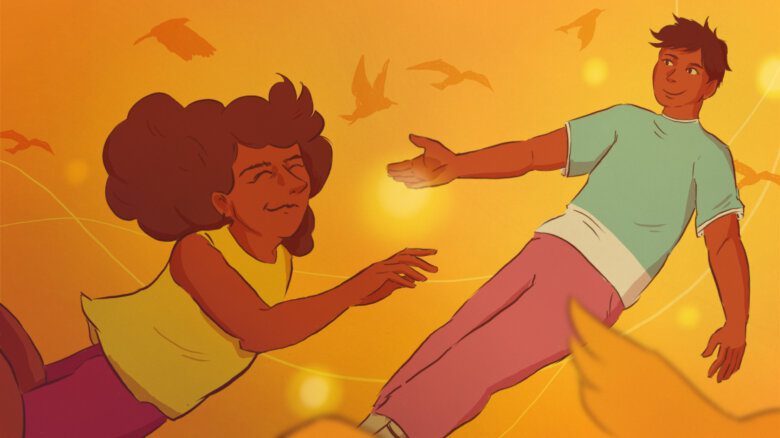
A Tom of Finland image from 1980. Credit: Tom of Finland
For many purists, leather’s erotic charge goes way back before conscious sexual orientation. “My first and very early–at the age of six or seven–interest was in riding-boots and breeches, which in England, after the First World War, were common sights,” recalls Jason, an enthusiast now pushing 90, who lives in California, and recounts his history on the fascinating site www.cuirmale.nl.
“Also, military uniforms, especially booted horse-soldiers and mounted policemen, gave me lots of excitement,” Jason goes on, sparing no detail. “Some motorcyclists wore long leather coats, like early pilots used to wear. Those early air-circus pilots were very dashing and exciting to my young eyes. They didn’t have leather pants, but wore tight white breeches and shiny boots with their leather jackets, and long white silk scarves flying out behind their leather helmets and goggles.”
A devotion to leather as end-in-itself is evident as well among the makers of chaps, harnesses, thongs, cuffs, and jackets–the fetish objects around which the scene revolves.
As the modern leather underground coalesced post-World War II, the motorcycle clubs that were its nucleus had to buy their gear from firms in the military and police trade. But today, gay leather has spawned a world of craftsmen–who, if they weren’t serving their communities–could be running high-end workshops in Montreal or Milan.
Naturally, such accomplished practitioners sometimes journey to water’s edge to catch the zeitgeist’s incoming tides. Black bomber jackets will sell perennially, says Northbound Leather president George Giaouris, but “young guys today are more into the brightly-colored motocross uniforms that have a superhero influence, as opposed to the Tom of Finland aesthetic that’s been popular since the 1960s and 1970s.”
Clubs in the leather scene operate along a continuum of strictness. Some welcome only leather-insiders, men who know the codes and rituals. Others are more open to the general gay world–people wearing leather on carefree whim, or those who enjoy a leather ambiance, but whose outfits are merely vegetarian or petrochemical. (Among fibers, leathermen hold Levi’s, if not fetish object themselves, the equivalent of a really good soy-burger). Some bars try to keep everyone happy by allowing entry through the front doors to anyone, but creating inner sanctums and special events nights where only the properly dressed get in. Or they maintain another, separate special leather-only satellite. In some cities, leather and drag go hand-in-hand, each drawing spark from its antipode. But in other places the two scenes show no mutual tolerance.
“The first couple times I was wearing black business slacks, a white dress shirt, and God forbid, wing tips,” recalls Dave Rhodes, publisher of The Leather Journal, about his first visits to a leather bar. He was generally ignored, but not bothered. “I sometimes wonder how much I would have developed in leather, if at all, if someone had found a way to embarrass me for not being up-to-code.”
The sense that it’s a realm in which one can “develop” also distinguishes leather from vanilla. No one would talk about “going far” in gay life and expect anyone to be sure what that means. Leather’s concern about codes is partly like a surgeon’s being careful to wear stain-free scrubs–in itself the particular detail might not matter, but surgery’s demand for absolute attentiveness and discipline does.
Leathersex encompasses practices–bondage, whipping, fisting, nipple torture, cutting, slings, mummification–that require the delicacy of a sushi chef and the sensitivity of a mother nursing her baby–not to mention a storyteller’s sense of pacing. And it’s not just about pulling off a convincing show, as one could say about comedy or drag. At its best, this attentiveness goes into transforming consciousness.
“In many cultures, the application of carefully chosen physical stress is a method for inducing transcendental mental and emotional states,” notes Pat Califia. And it’s not just a matter of sitting home alone and putting on the tit clamps. It’s the shared storyline that makes the scourging rituals of the Shias or the Easter-time Filipino crucifixion re-enactments not just individual crazymaking, but ways of getting deep into oneself, while also–at least potentially– profoundly connecting with one’s community.
“The men I knew and ran with then,” recalls leather philosophe Guy Baldwin of his experiences in the scene starting in the mid-60s, “saw and understood clearly that we were definitely not common, not average, and not conventional. For us, radical sexuality was our art form. And for a smaller number, it was also our religion, our salvation and destiny. It was the central, organizing principle of our lives.”
On the vanilla side of the fence, a contrary view predominates–with sex generally understood as something done best when one is fresh and green. Look at the groaning erotic bookshelf labeled My First Time–or its flipside, the contemporary belief that an early blow-job devastates a soul till the grave, and maybe beyond. If vanilla sex is Christianity, making child purity its central fetish, leather is more Confucian, appreciating the weathered flesh of experience.
Or maybe vanilla and leather play off each other, yin to yang. There are those who knew leather was their thing when they were five. But a more common pattern is for guys to discover leather in their late 20s or early 30s. Maybe fetish interests, like deep rock-formations bared by eroding soil, require the destructive force of youth’s erotic flood to be made manifest. Of course it’s not a bad career move, either: if you can’t compete in the meat market of young looks, why not switch to one where skill and experience can really count?
It’s notable that at the turn-of-the-1980s, post-Stonewall gay culture-at-large plumped for leather in a big way–just when its natural development was about to be shattered by AIDS. The clone phenomenon, which then dominated the urban gay aesthetic, was mustachioed, leather-clad, and thoroughly masculine. “Gay men of my generation and experience were beginning to understand,” writes Michael Bronski, “that we could become the men we wanted and felt we could never have–the men of our dreams.”
With its sexual abandon, the clone era strikes many of those who lived it–as well as those too young to have been able–as a golden, unfettered age. But in leather circles, the golden age, by wide consensus, is held to be a time of greater stricture–pre-Stonewall and post-World War II, the period of leather’s Old Guard.
Of course, there was an Older Guard, but they didn’t leave much of a footprint. Jason, our elderly Englishman, found a scene in the 1930s amidst the London Metropolitan Police barracks–where young constables were hosteled, a force kept at hand and leather-clad in case of urban unrest. Many of the coppers, Jason discovered, were alive to the pleasures of gay sex and leather–or at least those tastes were readily precipitated when a queer’s come-on sparked them. Not so much gay, they were probably simply sexually available, as a great proportion of young men were in Western societies well into the 1980s, and outside the West, still today.
As Jason’s police companions suggest, pre-Stonewall and especially prewar, the leather scene bubbled quietly at the margin and under the veil of other pursuits. The motorcycle magazines of the period provided a cover–and through their classifieds, a link–for those with homoerotic interests. (Opera magazines served a similar function.) But the dangers of exposure obstructed formation of any open scene.
The ’50s and ’60s, by contrast, maybe offered the golden mean of veiling versus freedom. Being completely upfront was not yet possible, of course. But the end of the war unleashed a flood of surplus military leatherwear, while the booming consumer market supplied cheap motorcycles. The war had shaken things up and moved people around, and for some veterans, the war’s horror found exorcism and balm in sadomasochism and brotherhood.
Leather grew aboveboard after Stonewall, with the rise of a leather press–notably, the now-defunct Drummer magazine–the proliferation of societies and clubs, the diminishing of motorcycle clubs, and the rise of title competitions, leather’s version of circuit parties. With the Internet providing a way to short-circuit them, bars and clubs face new competition themselves. Those tight cliques, where Baldwin found his mentors, are less in evidence today. Like an ageing kabuki master watching the young generation losing itself in anime, some worry about the loss of the old forms and ways.
Baldwin has concerns, but isn’t pessimistic. “Growing numbers of younger guys who came into radical sexuality through the Internet have finally begun to see the limitations of the cyber medium,” he says. “Posted text and pics are simply not reliable for judging erotic chemistry. That man who e-mailed those great photos might actually have no sex energy at all, maybe can’t talk in person, smells of perfume, lives with his aunt, is too tweaked to focus, is a crappy host, and is all about his fancy 800-thread-count sheets. Conversely, the plain looking guy standing across the room can feel sexy as hell, yet he’d get rejected online because his photo doesn’t reveal his heat.
“It’s still true that the best way to get the ‘feel’ of someone erotically is face-to-face,” Baldwin continues. “No technology comes close… I see more new guys [in leather bars] all the time.
Having survived Naugahyde and vinyl, leather will likely survive the age of online cruising. Leather is semantically rich in part because it’s so radically ambivalent, encompassing, and never quite resolving, its contradictions.
The first leather came from the skins of beasts man hunted to eat. And for hunting’s rough-and-tumble, those skins proved the best material to wear. Donning the flesh of his kill symbolizes a man’s triumph. But in doing so, the hunter can’t help partly assume the identity of the animal he’s vanquished, becoming victor in victim’s clothing, life dressed in death. The ultimate continuity of hunter and hunted is something almost all native cosmologies emphasize.
Ironically, the surest supply of leather came with farming and its associated animal domestication. Agriculture took men and boys out of the hunt, and fixed them firmly in the domestic sphere, nursing foals and seedlings. Agriculture’s enforced effeminization provoked the first crisis of male identity, argues one school of prehistorians, spurring the male, by compensation, to create and dominate patriarchal spheres of art, religion, culture, and warfare. The rest, as they say, is history.
Wearing leather was natural whenever work was hard–whether for blacksmiths beating hot metal into horseshoes, police facing a madding crowd, or pilots taking to the sky in open cockpits.
But leather’s not just useful. A symbol packs more oomph when its referent is fading. Nothing says phone like a disused black 1970s rotary model; nothing says car like a ’56 Impala. For the longest time, leather wasn’t a symbol–it was what certain categories of worker wore for good reason. It’s no accident that leather burst onto the scene as cultural phenomenon at another moment of crisis. The end of World War II not only threw a lot of surplus leather onto the market. It established that in a world of push-button nuclear missiles and automated factories, the men who’d recently worn that leather in the course of performing heroic deeds weren’t really needed anymore. It was the-end-of-the-hunt-at-the-rise-of-agriculture all over again.
The homoeroticism that was always essential to male socialization could be over looked–as it was among Catholic priests–so long as the male that emerged from that hot homo-crucible was necessary. It is biting irony that the gay movement could burst forth in the ’60s because unspoken homosocial bonds–in the hunt, on the battlefield, on-board ships–were now superseded. The view of homosexuality-as-identity championed by Magnus Hirschfeld savvily embraced this New World Order–making lesbians and gays sexually indeterminate, between-men-and-women. It was brilliant marketing, just a generation ahead of its time. Hirschfeld’s view triumphed in the West with the gay liberation movement, and his rivals, who defended homosexuality, in the Greek mode, as a maker of men, were defeated. As usually happens, the latters’ views were erased from public discourse, even largely from the history books.
Maybe the most interesting thing about leather is that guys who deck themselves out in all that outrageous gear manage to do something absolutely serious. Their costumes could so readily be “performance” in the acidic, post-modern, everything-means-nothing sense. But somehow it isn’t. Leather is poignant, and it can’t quite put its tongue on why. And that’s maybe because leather’s a meditation on masculinity. And a timely one, for the male has grown so ripe a symbol just because his underlying reality is fading away. By tangling itself around that key civilizational problem, leather has become one of the queerest, most interesting things going on.

 Why you can trust Xtra
Why you can trust Xtra


